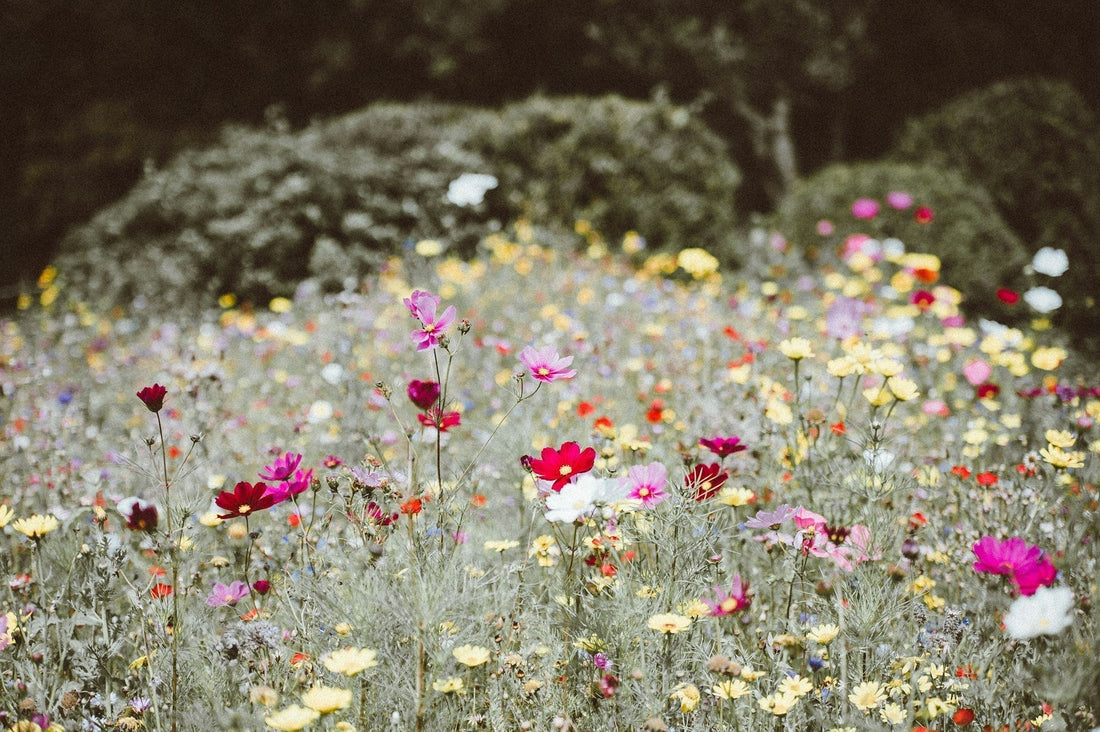A mini meadow garden is a beautiful and rewarding endeavor. Not only are the flowers gorgeous and provide food and shelter for beneficial insects, but a small meadow garden is also easy to take care of. Traditional lawns need so much constant care, but wildflower meadows become self-sufficient once established.
Meadows have declined by 50% in the last five decades. This dramatic decrease makes a small meadow garden project more vital than ever. If you’ve been thinking about it but haven’t acted yet, now is a good time!
A wildflower meadow is an environmentally responsible alternative to a yard and needs minimal care once it's 2-3 years old. A well-laid-out backyard meadow garden blends 60-65% native grasses with 35-40% flowering perennials. This mix creates a perfect home for wildlife and pollinators.
The best part? You don't need a huge space or special knowledge to begin. You can create a small meadow in any size space, from an entire backyard to a small patch in the front yard. The meadow garden will need 2 to 3 years to grow before the native plants start to bloom and produce seeds. Be patient during this time. In the end, you will have a beautiful, low-maintenance yard that is beautiful and supports local wildlife and beneficial insects.
Planning A Small Wildflower Garden
Before you plant a mini meadow garden, it's important to take time to analyze your space. This will help you avoid frustration and save resources later on.
Location
Sunlight plays a significant role in helping most wildflowers thrive. The ideal area should receive at least 6 hours of direct sunlight daily. Partial-shade wildflower varieties need a spot with at least 3-4 hours of sun. A mini wildflower meadow won't succeed in very shady corners. The area should be open without too many woody plants like shrubs and trees, unless they're spaced far enough apart to let sunlight reach the ground.
Size
A mini meadow can flourish in spaces as small as a 6×6 (36 sq feet) space. Many experts suggest 400 square feet as the minimum size to support a good diversity of wildflower species, but this isn’t absolutely necessary. Sure, you may not be creating the absolute best mini meadow, but any meadow is better than none. Especially when it comes to attracting and protecting beneficial insects.
Many beautiful and bright meadow plants can thrive in a strip under a window or along a fence. Limited space shouldn't stop you - the area could border a sidewalk, garden path, or become a wildflower bed in a small yard.
Soil
Most wildflowers flourish in well-drained soil with low fertility. A soil test can tell you about pH and organic matter content. The test results will help determine if your soil needs amendments. Wildflowers generally prefer poor soils, and you shouldn’t add fertilizer. Adding fertilizer encourages grasses to outcompete your flowers.
Considerations
Choose wildflower species based on the conditions of your site. For wet areas, select plants that can handle moisture, like cardinal flowers, blue vervain, and swamp milkweed. For dry areas, pick drought-tolerant plants. It’s important that the plants match your specific conditions, otherwise they won't grow well. Remember, mini meadows take time to develop, so be patient as your garden grows.
Preparing the Ground for Your Backyard Meadow Garden
Time spent preparing the site pays off when your mini meadow thrives. Your first task is getting rid of all vegetation in the garden space. Weeds and grass will fight your wildflower seedlings for water, nutrients, and light.
Ground Prep
The best meadow results happen when the site prep is done in the fall before spring planting. You can use back plastic to spread over the area and kill unwanted plants. This takes about 3-4 months, which is why it’s best to do it in fall/winter. Before covering the space in black plastic, mow the area as short as possible. Cover it with 4-6 mil thick black plastic. Secure the edges with soil or rocks.
If you have a small area to clear of weeds, use a sharp hoe or a sod cutter. For larger spaces, you may need to use a rototiller to loosen the soil up. Till it up to 3 inches deep, but be careful—this can bring up hidden weed seeds. We recommend avoiding tilling whenever possible.
Drainage
Most wildflower species need soil that drains well. Waterlogged soil can fill air spaces with water, which leads to root rot and fungal issues. To check the drainage, you can do a simple test. This test will help you understand how water behaves at the site. To test the drainage, dig an 18-inch deep, 12-inch wide hole and fill it with water - it should empty within 24 hours. If the drainage is poor, you can improve it by mixing in organic matter over several seasons. Serious drainage issues might need raised planting areas or underground drainage tiles.
Selecting the Perfect Plants for Your Mini Meadow
To have a successful mini meadow, it's essential to choose plants that will grow well where you live. Native wildflowers are very important to the plan. These plants have grown with local pollinators and are well-suited to your climate. Cowslip (Primula veris) makes an excellent starting point with its early spring flowers that provide nectar for insects. Red clover (Trifolium pratense) might look simple, but acts as a powerful magnet for bumblebees. Yellow rattle helps other wildflowers grow by weakening aggressive grasses. You'll also find great results with ox-eye daisy, mallow, yarrow, toadflax, ragged robin, and bird's-foot trefoil.
Wildflower Perennial Seed Mix - Isla's Garden
Grasses, sedges, and rushes should make up 40% to 70% of your meadow plants. They provide vital structure, keep soil stable, prevent erosion, and help control aggressive wildflowers naturally. Little Bluestem works beautifully in small wildflower gardens with its blue-green summer foliage that turns bronze-orange in fall. Broomsedge and Eastern narrow-leaved sedge are also excellent choices. These grasses add height, movement, and year-round beauty to your mini meadow.
Your garden can bloom all season long with the right mix of wildflowers. In spring, early-bloomers like cowslip brighten up the meadow. Coneflowers and black-eyed susans fill the summer months with flowers. Asters and goldenrods are excellent and provide vital late-season nectar to pollinators.
You can create a haven for pollinators by adding specific host plants. Monarch butterfly larvae rely solely on milkweed for food. Mountain mint, bee balm, and coneflower bring many beneficial insects to your garden. Different pollinators like specific flower shapes and colors - bees love blue, purple, and yellow blooms with easy-to-reach pollen, while butterflies prefer pink, purple, and yellow flowers with flat landing spots.
How To Create A Four-Season Mini Wildflower Garden
Fall is the best time to plant most wildflower meadows. Many seeds need the cold winter temperatures, and then will break their dormancy naturally in the spring. The ideal planting period is from late September to early December. The sweet spot is usually mid to late October, right before November's unpredictable weather sets in. You can also plant in spring if you keep your seeds in a cold (35-40°F), dry place through winter.
Plug plants give your mini meadow a solid start with predictable outcomes. These small, ready-to-plant specimens create immediate structure and visual appeal. While they cost more than seeds, plug plants work best in compact spaces and let you place specific species exactly where you want them. These plants need less water to establish and compete better against weeds.
Plant your plugs 5-10 inches apart to create a natural meadow appearance. This gap lets plants spread while forming thick growth that keeps weeds away. Press seeds firmly into the soil surface after spreading them in seeded areas. Good seed-to-soil contact helps anchor roots and boosts germination success.
Seeds are a budget-friendly option to cover bigger areas. You should scatter wildflower seeds on top of the soil instead of burying them since many need light to grow. Small areas work best with hand broadcasting (throwing seeds).
You'll get even coverage by mixing your seeds with a carrier material. Mix one part seed with eight parts sand or vermiculite, and add a bit of moisture so the seeds stick to the particles. Break your space into sections of 400-500 square feet. Walk in one direction to spread half the seed mixture, then walk perpendicularly to spread the rest.
Good seed-to-soil contact is vital after broadcasting - it keeps seeds anchored and prevents them from washing away. You can rake the area lightly (no deeper than ¼ inch) or use a lawn roller to press seeds into the soil. A thin layer of clean straw (one bale per 1000 square feet) provides extra protection to hold seeds in place.
The first year's care centers on managing moisture. Water gently right after planting if you don't get rain within a couple of days. Your seedlings need consistent moisture until they reach 6-8 inches tall, which takes about 4-6 weeks. Morning watering becomes critical during hot spells.
Annual wildflowers bloom quickly, but perennial meadow plants focus their early energy on root development. They often don't flower until their second or third year. Your patience will be rewarded with an enduring, self-sustaining wildflower paradise.
The first few weeks after planting need careful attention to water. Start with a gentle but thorough soaking of your seeds or plugs. Keep the soil moist consistently for 4-6 weeks until seedlings grow 6-8 inches tall. Hot weather might require watering once or twice daily.
Native wildflowers become self-sufficient once they take root. During dry periods, water the plants deeply. This helps the plants thrive without needing regular watering. Just be careful not to overwater established plants -- this can lead to root rot and fungal issues.




